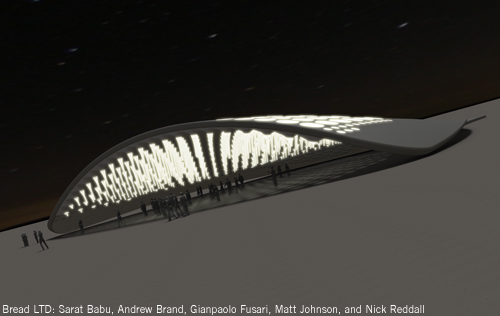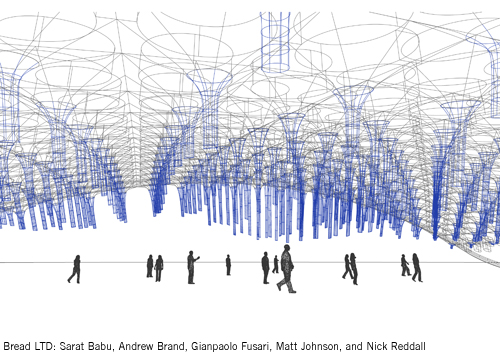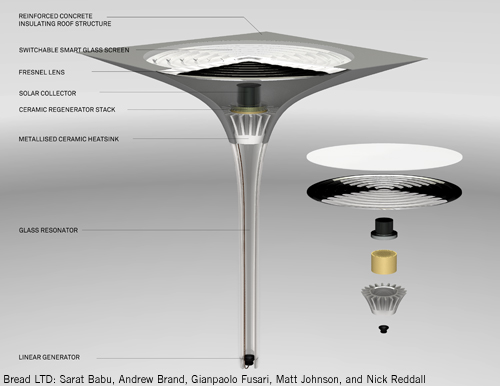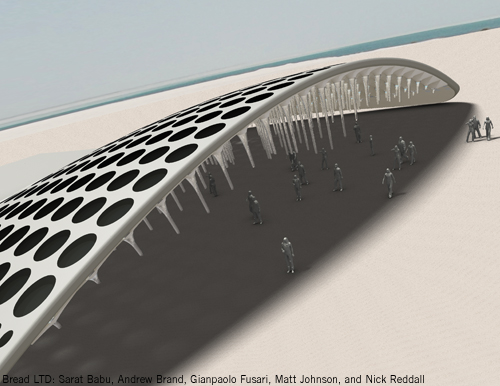Bread LTD
Sarat Babu, Andrew Brand, Gianpaolo Fusari, Matt Johnson, and Nick Reddall
Designed for Site #2 in Abu Dhabi, between Saadiyat Island and Yas Island.

Design Submission for the 2010 Land Art Generator Initiative Design Competition
Artist’s descriptive text:
A transition from a world powered by fossil fuels to a world powered by renewable resources is built on two pillars, technology and culture. The technology must exist to harness the energy that is present in our environment, and culture must support the changes that our planet requires. BREAD proposes that the next step in this dual transition is to reach back into our cultural legacy to find a forgotten figurehead for technological and cultural progress, the organ. Powered only by the sun, using a technology known as thermoacoustics, the Solar Organ will produce both sound and electricity. Viewers will have a chance to walk within the organ’s structure, absorbed by the soft ethereal tones of this musical instrument, knowing that as it produces sound it is also feeding energy back into the grid. The goal of the installation is to demonstrate the energy present in the environment around us through an instrument that produces both beautiful music and electrical energy.

From Ctesibius of Alexandrea’s first organ in B.C. 2000 to Giacomo Antegnati’s organ in Milan’s Duomo, for almost 4000 years this instrument played the role of the technical avant-garde, funneling the world’s famous composers through networks of pipes and valves. Before the industrial revolution, organs represented global technical achievement. Capable of producing sound in a broader range than any other single instrument, the great wind organs had up to 10,000 pipes, some of which were 19 meters in length. An organ was a demonstration of a society’s technical prowess and commitment to culture. Today though, the wind organ has been replaced by contemporary electronics and is no longer the technical or aspirational figurehead that it was. In comparison to contemporary technologies, the organ is often seen as an antiquated instrument. Unfortunately this view misses the organ’s true beauty, the way in which it transforms energy into sound, and wind into emotion. This transformation is governed by the most basic physical laws of our world, giving the organ a beautiful simplicity.
Recapturing this elegance is essential when we look forward to future of energy resources. We must learn to capture the energy that exists around us rather than reaching into the ground. Global culture needs to change to appreciate the intelligence of satisfying our energy needs through wind, water and the sun. BREAD proposes the Solar Organ to act as a way to both reveal the untapped renewable energy present in the environment, and to act as an international platform for musical expression. The Solar Organ will be an installation that will allow contemporary composers and musicians to manipulate its mechanics, allowing the very movement of the sun to play their melodies. The organ will produce beautiful, clear, purely analog sound and electrical energy through the most renewable of resources, the sun. Rather than being played by a musician, the solar organ will be played by the sun itself. As the sun rises high in the sky its energy will be focused into the internal structures of the organ producing tones as ethereal and magical as the desert. As the sun moves across the sky, shadows created by active optics within the structure will control which tones are being generated so the presence of the organ will evolve throughout the day.

The Solar Organ’s primarily role is to change solar energy into sound and electricity. Known as a thermoacoustic hot air engine, the solar organ will transform the heat from the sun into a high-amplitude standing sound wave by creating a temperature differential within the device. The thermoacousitc engine is one of a family of “Stirling” type engines that transform ambient energy sources into work. The magic of these devices is that they capture and focus energy sources that exist slightly below our conscious perception, transforming them into active work that we can understand. The solar organ will demonstrate to viewers both the incredible amount of ambient energy present in the desert environment, and the potential for that energy to take many forms.
The Solar Organ has 27 distinct notes, each consisting of seven major components. A Fresnel lens, a switchable smart glass plate, a solar collector, a ceramic regenerator matrix, a metallised ceramic heatsink, a glass resonator, and a vibrating membrane for electrical power generation (linear alternator). Each of these units is self-contained. The tubes vary in length from 2.6 m to .669 m, the respective frequencies would be 65.41 Hz and 261.63 Hz, giving a potential energy output of 27 Megawatt hours per annum. The Solar Organ functions by absorbing heat from the sun, which heats the air within the unit, generating a standing sound wave. This sound wave will both create tones to be heard by viewers as well as powering a linear alternator which will generate electricity. The frequency (and thus the note) of the sound is controlled through manipulation of the physical characteristics of the resonator. The linear alternator is most basically a loudspeaker run in reverse. Instead of using a current to move the speaker cone back and forth (creating sound), the cone of the speaker is moved by the sound wave, generating electrical power.
As the Solar Organ requires time to absorb heat from the sun to create its tones, it cannot be “played” like a conventional organ. Rather, the solar organ can be programmed through control of the switchable smart glass. The smart glass can quickly shift between being opaque or transparent allowing for precise control over the solar load received by each unit, thus controlling the timing of notes and the creation of polyphonic chords. The programming includes relational timing between notes, but also absolute timing relative to the time of day. For example, the programming could be designed in such a way that the organ will only play at dawn or at dusk. Its malleable nature means that the solar organ will offer an increasable range of expression, all the while generating electricity to be fed back into the grid.

The Solar Organ will offer viewers two important experiences. First, it will enthral them with the soft but powerful tones of this large musical instrument. As they walk within the structure of the organ they will be left to wonder how such a simple device can create such incredible melodies using nothing other than sunshine. The second experience will be the realisation that by embracing the energy present in the world around us we can meet our needs and work within and alongside our environment rather than compromising it. Those who have walked through the site will leave with a glimpse of an energy future that works together with a changing culture to create elegant and beautiful solutions to our most pressing problems.
Related Posts
2 Comments
Add comment Cancel reply
This site uses Akismet to reduce spam. Learn how your comment data is processed.

[…] The solar organ Share this:TwitterFacebookPrintEmailLike this:LikeBe the first to like this post. Filed under Uncategorized | Leave a comment […]
[…] a changing culture to create elegant and beautiful solutions to our most pressing problems. Source: Land Art Generator Initiative Reageer […]